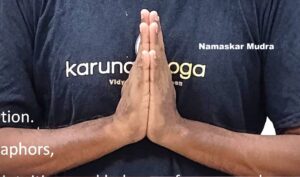Namaskār Mudrā
Introduction
Namaskār Mudrā is one of the most fundamental hand gestures in yoga, spirituality, and Indian culture. It is also known as Pranām Mudrā or Anjali Mudrā, commonly recognized as the gesture of greeting (Namaste). In yogic philosophy, it is not only a social expression of respect but also a spiritual seal (mudrā) symbolizing the union of individual consciousness with universal consciousness.
It is widely used in prayer, meditation, yoga practice, rituals, and greetings across traditions in India, Buddhism, Jainism, and beyond.
Meaning
Etymology:
Namaskār = “paying obeisance, salutation, bowing with reverence.”
Mudrā = “seal, gesture, psychic lock.”
Literal Meaning: “Gesture of Reverence or Salutation.”
Symbolism: The joining of the palms at the heart symbolizes oneness, humility, surrender, and respect. It signifies the meeting of dualities — self and other, inner and outer, human and divine.
How to Perform Practice
Sit in Sukhasana (easy pose), Padmasana (lotus pose), or stand in Tadasana (mountain pose).
Bring both palms together, fingers pointing upward, thumbs resting lightly against the sternum (heart center).
Press the palms evenly, keeping shoulders relaxed and elbows slightly away from the body.
Bow the head slightly, closing the eyes to deepen awareness.
Breathe calmly and focus on the Anāhata (heart chakra) or silently repeat a mantra such as Namaste or Om Shanti.
Variations:
Held at the forehead (Ajna Chakra) to express surrender of intellect.
Held at the crown (Sahasrāra) in deep devotion.
Common in yoga sequences like Surya Namaskar (Sun Salutation).
Benefits
Physical Benefits
Improves postural alignment by centering the body.
Strengthens wrists, fingers, and forearms.
Encourages deep breathing and chest expansion.
Relaxes the shoulder and neck muscles.
Mental & Emotional Benefits
Instills humility, gratitude, and calmness.
Reduces stress, anger, and emotional fluctuations.
Improves focus, mindfulness, and present-moment awareness.
Fosters compassion, love, and respect for others.
Spiritual Benefits
Activates Anāhata Chakra (heart center).
Harmonizes right and left hemispheres of the brain.
Cultivates oneness with the divine and dissolves ego.
Enhances prayer, mantra chanting, and meditative practices.
Contraindications
Generally safe for everyone.
Individuals with acute wrist injury, arthritis, or palm trauma may need to modify or avoid long practice.
Anatomy & Physiology
Engages muscles of the hands, wrists, forearms, and shoulders.
Opens chest cavity, promoting deeper oxygenation.
Activates parasympathetic nervous system, lowering stress hormones.
Pressing palms together creates mild isometric contraction, enhancing circulation.
Kinesiology
Bilateral symmetry of the body is emphasized.
Involves isometric muscle contraction of palms and forearms.
Supports coordination, proprioception, and balanced muscle activation.
Engages scapular stabilizers (trapezius, rhomboids) for upright posture.
Neurology
Stimulates sensory receptors in both palms → bilateral brain activation.
Balances left (logic) and right (intuition) hemispheres.
Promotes alpha brain wave activity, calming the mind.
Enhances vagal tone, improving emotional regulation.
Duration of Mudra
Casual Greeting: a few seconds.
Meditative Practice: 5–15 minutes.
Spiritual Devotion: up to 30 minutes with mantra or prayer.
Counter Mudra
Chin Mudra – for grounding and focus if Namaskār Mudrā feels too devotional.
Hridaya Mudra – to deepen heart healing and release emotional tension.
Conclusion
Namaskār Mudrā is much more than a gesture of greeting — it is a spiritual seal that embodies unity, humility, and reverence. By bringing the palms together at the heart, one honors the divine essence in oneself and in others. Physically, it improves posture and coordination; mentally, it calms the mind; spiritually, it awakens compassion and devotion. It is a universal mudrā of connection, respect, and inner balance.
FAQ
Q1. Is Namaskār Mudrā the same as Anjali Mudrā?
Yes, they are often used interchangeably, though Namaskār emphasizes greeting while Anjali emphasizes offering.
Q2. Which chakra does Namaskār Mudrā activate?
Primarily the Anāhata (Heart Chakra).
Q3. Can it be practiced during asanas?
Yes, widely used in poses like Tadasana, Vrksasana, and Sun Salutations.
Q4. Is it only cultural or also yogic?
It is both — culturally used as greeting (Namaste), and spiritually as a powerful yogic mudra.
References
Swami Satyananda Saraswati – Asana, Pranayama, Mudra, Bandha
Gertrud Hirschi – Mudras: Yoga in Your Hands
Joseph & Lilian LePage – Mudras for Healing and Transformation
Swami Niranjanananda – Yoga Darshan
Feuerstein, Georg – The Yoga Tradition

